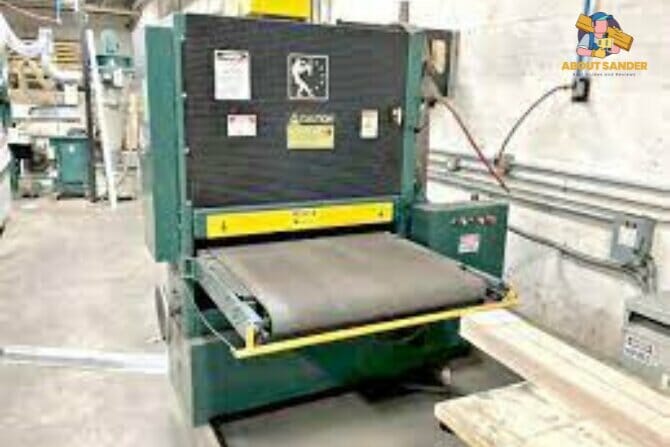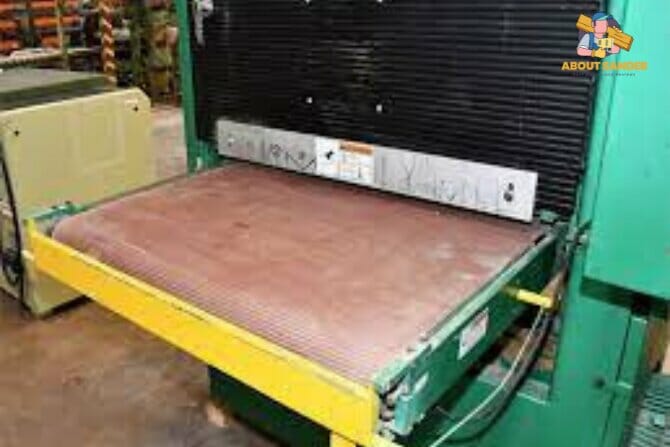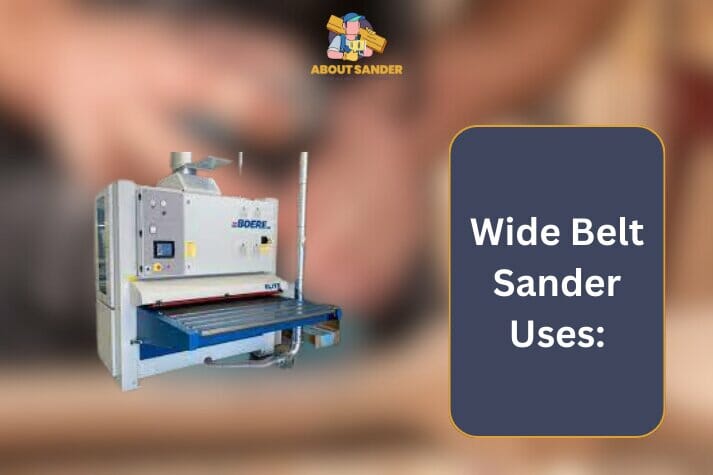A wide belt sander is used for efficiently sanding and smoothing large surfaces, such as wood panels, doors, and tabletops. It’s a powerful woodworking tool that helps achieve consistent and uniform finishes, removes material efficiently, and prepares surfaces for painting, staining, or other finishes.
Its wide sanding belt covers a larger area, making it ideal for industrial settings and large-scale projects where speed and precision are paramount.
Wide belt sanders are versatile tools that find applications in various industries. These powerful machines are designed for efficiently sanding and shaping multiple materials, from woodworking to metalworking.
This article will explore the diverse wide belt sander uses and how it can enhance productivity and quality in different manufacturing processes.
Key Takeaways:


- Wide belt sanders are robust machines with diverse applications in woodworking, metalworking, automotive, furniture manufacturing, and more industries.
- They are used for achieving smooth surfaces, precise dimensional control, surface preparation, and leveling uneven surfaces.
- Wide belt sanders enhance efficiency and precision in sanding, shaping, and surface preparation tasks.
- They are valuable tools for Indal use and DIY projects, offering versatility and professional-quality results.
Exploring 10 Wide Belt Sander Uses: Enhancing Efficiency and Precision
Here some of the most common wide belt sanders uses.
1: Woodworking:
Achieving Smooth and Flawless Surfaces In woodworking, wide belt sanding creates smooth and flawless surfaces on various wooden materials. They effectively remove imperfections, such as machine marks, scratches, and unevenness, leaving behind a pristine finish.
- Panel Sanding: Wide belt sanders are ideal for sanding large panels, such as plywood, particle board, or MDF (medium-density fiberboard). They ensure consistent and even sanding across the entire surface, resulting in a smooth and uniform appearance.
- Solid Wood Sanding: Wide belt sanding is employed to sand solid wood pieces, including tabletops, cabinet doors, and furniture components. They help achieve a smooth surface while preserving the natural beauty of the wood grain.
- Veneer Sanding: When working with veneered surfaces, wide belt sanders are used to delicately sand the thin layer of wood while maintaining its integrity. This ensures proper veneer adhesion and creates a seamless, polished finish.
2: Cabinet Making:
Precise Dimensional Control Cabinet makers rely on wide belt sanders to achieve exact dimensional control of their wooden components. These machines allow them to sand panels to uniform thickness, ensuring seamless joins and a consistent aesthetic. Additionally, wide belt sanders create flush edges, aligning adjoining panels for seamless cabinet construction.
- Thickness Sanding: Wide belt sander uses are to sand panels to the desired thickness, ensuring consistency throughout. This is essential for achieving flush joints and proper alignment during cabinet assembly.
- Edge Sanding: Cabinet components, such as doors, drawers, and trims, often require edge sanding to create smooth and uniform edges. Wide belt sanders enable precise edge sanding, resulting in seamless transitions between adjoining components.
3: Metalworking:
Preparing Metal Surfaces for Finishing Wide belt sanders is also crucial in metalworking processes. They prepare metal surfaces by removing rust, scale, and paint, providing a clean and smooth foundation for subsequent treatments like painting, powder coating, or plating. Wide belt sanders with specific abrasives are capacity-achievable finishes on metal parts, improving their aesthetic appeal and durability.
- Surface Preparation: Wide belt sanders effectively remove surface contaminants, oxidation, and coatings from metal parts, ensuring optimal adhesion of subsequent finishes. They create a clean and consistent surface for further treatment or assembly.
- Deburring and Edge: Radius-in-radius belt sanders equipped with specialized abrasive belts can remove sharp edges and burrs from metal parts, enhancing safety and functionality. They also facilitate edge radiusing, creating smooth and rounded edges.
4: Automotive Industry:
Refinishing and Restoration In the automotive industry, wide belt sanders find application in refinishing and restoration work. They remove old paint, surface imperfections, and blemishes from vehicle body panels, ensuring a clean and even surface for the applapplyingnt. Wide belt sanders aid in achieving a professional finish, rejuvenating classic cars and res, touring them to their former glory.
- Paint Stripping: Wide belt sanders equippedropriate abrasives can efficiently strip multiple layers of old paint from automotive body panels, saving time and effort compared to manual methods.
- Surface Leveling: Wide belt sander uses to level out surface imperfections, such as scratches, dents, or unevenness, before applying a new coat of paint. They create a smooth and uniform surface, ensuring a flawless paint finish.
5: Furniture Manufacturing:

Smoothing and Shaping Wood Components Furniture manufacturers extensively utilize wide belt sanders to smooth and shape various wooden components. These machines excel in sands, chair seats, armrests, and other furniture parts, creating a consistent and polished appearance. Wide belt sanders are also adept at shaping curved or irregular wooden pieces, allowing for intricate and customized designs.
- Surface Finishing: Wide belt sander uses on smooth and even surfaces on furniture components, eliminating imperfections and creating a polished appearance. They contribute to the overall aesthetics and quality of the finished furniture.
- Contour Sanding: Wide belt sanders with specialized attachments can shape and sand curved or irregular furniture components, such as chair arms or table legs. This enables furniture manufacturers to create unique and visually appealing designs.
6: Flooring Industry:
Surface Preparation and Refinishing Wide belt sanders play a vital role in the flooring industry installation and refinishing processes. They are employed to level uneven surfaces, remove previous finishes, and create a smooth base for installing new flooring materials. In refinishing projects, wide belt sanders help strip old finishes, stains, and scratches, restoring the beauty and luster of hardwood floors.
- Surface Leveling: Wide belt sanders are used to level uneven subfloors or remove high spots, ensuring a flat and stable surface for installing flooring materials. This helps prevent issues such as squeaks or gaps in the finished floor.
- Finish Removal: Wide belt sanders equipped with appropriate abrasives efficiently remove old finishes, stains, and coatings from hardwood floors, preparing them for refinishing. They strip away the worn layers, revealing a fresh surface ready for new treatments.
7: Door Manufacturing:
Achieving Seamless Joints and Smooth Profiles For door manufacturers, wide belt sanders are essential in Achieto’s attains joints and smooth profiles. These machines ensure door panels fit together perfectly, eliminating gaps or irregularities. They also create uniform profile shape tours on door edges, enhancing the overall aesthetics and functionality of the finished product.
- Joint Sanding: Wide belt sanders are used to sand the edges of door panels, ensuring a precise fit and seamless joints. They help create a flush surface between adjoining door components, enhancing the structural integrity and appearance of the door.
- Profile Sanding: Wide belt sanders with profile sanding attachments or custom-designed abrasive belts can shape door edges and profiles, creating consistent and visually appealing contours. This allows for the production of doors with unique designs or customized features.
8: Plastic Industry:
Preparing Plastic Parts for Assembly Wide belt sanders also finds utility in the plastic industry. They prepare plastic parts for assembly by removing flashes, burrs, and imperfections. Wide belt sanders with specialized abrasives and techniques help achieve smooth and clean edges, ensuring precise fitting and seamless assembly of plastic components.
- Flash and Burrs Removal: Wide belt sanders effectively remove excess material, such as flash or burrs, from plastic parts, improving their dimensional accuracy and quality. This ensures proper fit and alignment when assembling plastic components.
- Edge Finishing: Wide belt sanders can be smooth and clean edges on plastic parts, removing any sharp or rough areas that may pose a safety risk or affect the functional product’s functionality and contribute to the overall quality and aesthetics of plastic components.
9: Boatbuilding:
Preparing Surfaces for Coating and Finishing In boatbuilding, wide belt sanders are surfaces for coating and finishing. They remove mill marks, surface imperfections, and old coatingslayersng a smooth and clean base for applying marine-grade paints, varnishes, or gel coats.
- Surface Preparation: Wide belt sanders are used to prepare boat surfaces, such as fiberglass, wood, or composite materials, by removing imperfections, contaminants, and previous coatings. They create an ideal surface for the applapplyinggrade finishes, ensuring durability and resistance to water damage.
- Fairing and Smoothing: Wide belt sanders can fair and smooth surfaces on boat hulls or decks. They help achieve a streamlined and aesthetically pleasing appearance while ensuring optimal hydrodynamic performance.
10: DIY Enthusiasts:
Versatile Tool for Various Home Projects Wide belt sanders are not limited to industrial applications alone; they are also precious for DIY enthusiasts. From refinishing furniture and restoring antiques to preparing surfaces for painting and staining, wide belt sanders offer a versatile solution for numerous home improvement projects.
- Home Renovations: Wide belt sanders are used in DIY home renovations for tasks such as refinishing hardwood floors, sanding and smoothing walls or ceilings, or preparing surfaces for painting or staining.
- Furniture Refinishing: DIY enthusiasts can utilize wide belt sanders to strip old finishes, sand furniture surfaces, and create a smooth base for refinishing projects. They aid in bringing new life to worn-out or outdated furniture pieces.
Frequently Asked Questions
1: What are the primary uses of a wide belt sander?
Wide belt sanders are primarily used for achieving smooth and flawless surfaces on various materials. They find extensive applications in woodworking, cabinet making, metalworking, automotive refinishing, furniture manufacturing, and more. These machines are instrumental in sanding large panels, shaping wood components, preparing metal surfaces for finishing, and leveling uneven surfaces in the flooring and boatbuilding industries.
2: Can wide belt sanders be used for DIY projects?
Absolutely! Wide belt sanders are not limited to industrial applications alone. They are precious for DIY enthusiasts as well. From refinishing furniture and restoring antiques to preparing surfaces for painting and staining, wide belt sanders offer a versatile solution for home improvement projects.
3: How do wide belt sanders contribute to efficiency and precision?
Wide belt sanders enhance efficiency by removing imperfections, such as machine marks, scratches, and unevenness, from surfaces quickly and consistently. They provide precise dimensional control in cabinet making and help achieve seamless joints and smooth profiles in door manufacturing.
Expert Verdict: The Pros and Cons of the Wild Belt Sander
As a seasoned sander expert, I’ve had the privilege of exploring and utilizing a wide range of sanding tools, each catering to different needs. Among these, the Wild Belt Sander stands out with its unique features and versatile applications. However, as with any tool, there are aspects that I appreciate and others that leave room for improvement. In this expert verdict, I’ll delve into why I like the Wild Belt Sander and where I believe it falls short.
What I Like:
- Powerful Performance: The Wild Belt Sander impresses with its robust motor and high-speed sanding capabilities. This makes it a go-to tool for heavy material removal and rapid sanding across large surfaces. Its power ensures efficiency in completing tasks quickly.
- Versatility: One of the standout qualities of the Wild Belt Sander is its versatility. It excels in various applications, from smoothing rough wooden surfaces to preparing floors for refinishing. Its adjustable settings allow for fine-tuning, catering to different materials and projects.
- Ease of Use: Despite its power, the Wild Belt Sander is designed with user-friendliness in mind. Its ergonomic grip and intuitive controls contribute to reduced user fatigue during extended sanding sessions. This is crucial for both DIY enthusiasts and professionals alike.
- Dust Collection System: Many sanding tasks generate a significant amount of dust, which can be both messy and a health hazard. The Wild Belt Sander’s integrated dust collection system helps keep the workspace cleaner and ensures a healthier environment for users.
Where It Falls Short:
- Weight and Maneuverability: While the Wild Belt Sander’s power is commendable, it can also be a drawback. The tool’s weight and size might make it less maneuverable in tight spaces or for overhead tasks, limiting its applicability in certain scenarios.
- Noise and Vibration: High-power sanders often come with higher levels of noise and vibration. The Wild Belt Sander is no exception, and prolonged use without proper hearing protection can be discomforting. Manufacturers could focus on noise reduction and vibration damping technologies.
- Precision Sanding: The Wild Belt Sander’s primary strength lies in rapid material removal, which might not be ideal for tasks requiring delicate precision. While it’s versatile, it might not be the first choice for intricate woodworking or finish sanding.
- Belt Tracking: Some users have reported challenges with consistent belt tracking on the Wild Belt Sander. This can lead to uneven sanding results and frustration during use. Improved tracking mechanisms would enhance the overall user experience.
In conclusion, the Wild Belt Sander is a powerful and versatile tool that offers significant advantages for various sanding tasks. Its impressive performance, ease of use, and dust collection system make it a valuable addition to any workshop. However, its weight, noise levels, and limitations in precision sanding are aspects that manufacturers could address to elevate the tool’s overall usability. As a sander expert, I appreciate the Wild Belt Sander’s strengths while recognizing areas for improvement, and I look forward to seeing how this tool evolves in the future.
Conclusion:
In conclusion, the wide belt sander is a versatile tool with many wide belt sander uses. Wide belt sanders have emerged as indispensable tools across various industries, from woodworking to metalworking, automotive to furniture manufacturing. Their versatility, efficiency, and ability to deliver precise results make them invaluable in enhancing productivity and achieving superior finishes.

Why Trust About Sanders?
When it comes to the world of sanding and sanders, you need a trusted source of information and guidance to ensure you achieve those perfect finishes. That's where I come in – I'm Martin, a dedicated sanding enthusiast with a relentless passion for attaining flawless surfaces. With years of hands-on experience in the sanding industry, I've honed my skills and expertise to provide you with the most reliable and accurate insights. What sets me apart is my commitment to excellence. I meticulously handpick each sander after rigorous testing, ensuring that only the best tools make it to your hands. My goal is to empower you with the knowledge and recommendations you need to tackle any sanding task confidently. When you trust About Sanders, you're putting your faith in a seasoned expert who shares your passion for perfection and strives to deliver top-notch information and reviews for every sanding challenge.
